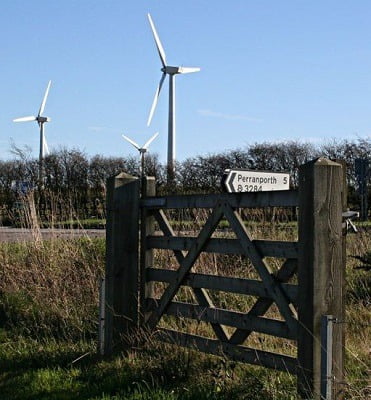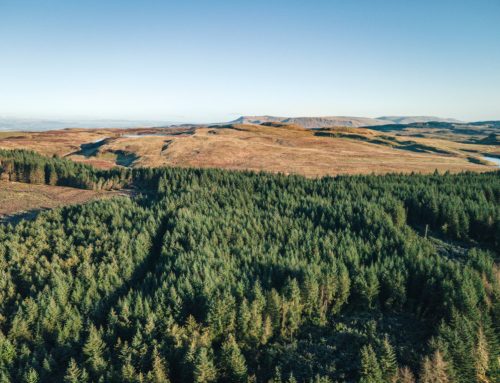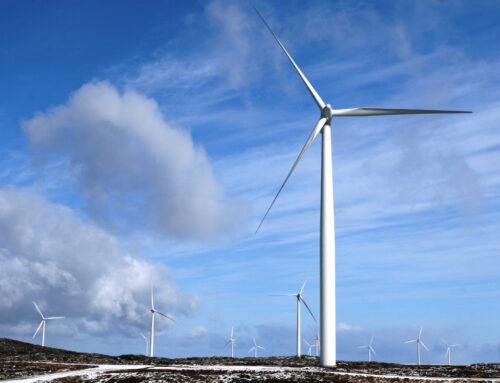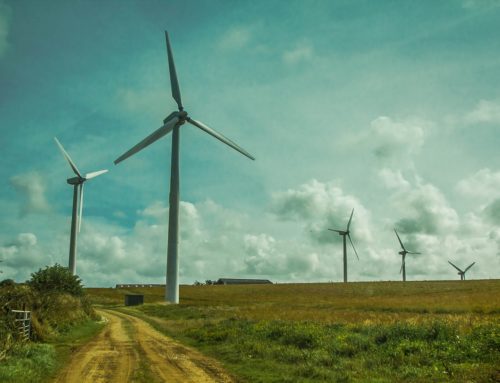by Chloe Bines
7 minute read
This summer has seen record generation from wind energy, with the UK’s wind turbines delivering more energy than our declining coal plants on several days and even managing to outstrip nuclear on 29th August.
Over the course of August wind energy met 10% of power demand, a substantial contribution, although still rather less than the monthly record set last December of 13%. However, on 17th August wind power broke all previous records, meeting 22% of total demand, thanks to the strong winds off the back of hurricane Bertha coupled with relatively low levels of power demand typical of summer. The increasing role of wind energy is undeniable and it’s asserting itself as a key element in the low carbon energy mix.
Yet whilst generation rates are at an all-time high, consent rates for onshore wind energy developments appear to be at an all-time low. So how can we explain this strange turn of events, and what is likely to come next?
How many plans must a man turn down?
Despite aspiring to be the “greenest government ever” the coalition has done little to encourage the deployment of onshore wind energy. Indeed, some Conservatives give the impression of being antagonistic to the formerly burgeoning industry.
Communities Secretary Eric Pickles has been perhaps the biggest obstacle to new onshore wind, having taken powers in October 2013 to call in any planning decision on a renewable energy project, giving himself and his department the ability to decide their fate. Between October 2013 and June 2014, Mr Pickles rejected 11 out of 13 onshore wind applications, five of which had been recommended for approval by the Planning Inspectorate. Warming to his role, in April he extended his power to call in applications for another year.
Industry commentators have suggested that councils across England are following Pickles’ lead and turning down more applications. Perhaps more worryingly, the Planning Inspectorate seems to be doing the same, when applications go to appeal. The result? Where 77% of applications were consented in 2011, in the first half of 2014 this fell to just 33%.
The rhetoric from other senior Conservatives has further dented Industry confidence. While serving as Energy Minister, Michael Fallon announced that if returned to power in 2015 the Conservatives would end subsidies for onshore wind; shortly after, he was promoted to the role of Defence Secretary. Lord Deben (former environment minister John Selwyn Gummer) has been widely quoted as saying that the UK has “enough” onshore wind capacity to meet its 2020 targets; he isn’t wrong, but the message is far from helpful, especially coming from the chair of the Committee on Climate Change (CCC).
How many years ‘til a target is missed?
In order to achieve the 2020 target of sourcing 15% of our energy from renewable resources the government’s Renewable Energy Roadmap suggests that the UK will need around 13GW of onshore wind. The latest figures suggest that around 7.6 GW is currently operational with another 13.7GW in the pipeline. A proportion of prospective projects will most likely fall by the wayside, especially in the current planning climate, yet it is fair to assume that the UK is on track for 2020.
However, with legally binding targets in place to reduce emissions by 80% by 2050, the UK carbon reduction commitment goes way beyond 2020 and we must not rest on our laurels. While the Government has yet to set out the next level of targets, modelling published by the CCC suggests that the most cost effective way to achieve the 2050 commitment is to increase onshore wind deployment. The CCC has modelled four scenarios – ambitious nuclear, ambitious renewables, ambitious CCS and higher energy efficiency. Interestingly in all four scenarios the expected level of onshore wind is 25GW installed capacity by 2030, even where ambitious offshore wind deployment is modelled. Lord Deben’s words have been interpreted by some as meaning that we have enough onshore wind capacity to meet the 2030 target; and that clearly is not the case.
Whilst onshore wind energy may not be in favour with the current administration, evidence from the last decade and forward modelling shows that onshore wind energy is, and is expected to remain, an important and cost-effective element of the energy mix. Any future government would be unwise to exclude the possibility of further deployment of onshore wind energy.
How many times must the power grid fry?
If a future government does heed the advice of the CCC, increasing wind energy deployment will bring its own challenges, not least in balancing the grid. Areas of the ageing distributed grid network in Cornwall, Devon and Wales are already saturated with renewable energy capacity and the upgrades required for new connections are proving prohibitively expensive.
Fortunately, the industry has responded with pragmatic solutions to overcome such barriers. Collaborative working groups, led by industry bodies such as Regen SW, are enabling developers to work together to reduce grid reinforcement costs and deliver projects where grid connections were previously too costly.

Is the path towards increased deployment of onshore wind blocked? Photo by Tony Atkin, via Wikimedia Commons.
As opponents of wind power are keen to emphasise, increasing our reliance on this source of power also brings the problem of intermittency of supply. Whilst managing supply and demand is already a daily challenge for grid engineers, increasing renewable energy coming on stream will require more innovative ways of balancing the system.
Western Power Distribution (WPD) is leading the way developing methods to deal with such challenges. The Future Networks team at WPD is trialling a number of new techniques with the aim of simplifying and increasing flexibility in energy network management. Their FALCON (Flexible Approaches for Low Carbon Optimised Networks) project is exploring the use of automatic load transfer between grid feeders, the implementation of interconnected 11kV networks, deployment of new battery technologies and the use of demand response services.
If successful, these techniques could be rolled out across the country to enable a more flexible distribution network designed for greater renewable energy capacity and more efficient management.
The answer my friends is owning local wind
Despite the complexities, overcoming technical challenges may prove easier than winning over the communities that will have to accommodate increased wind energy deployment. It may come as a surprise to learn that polls often suggest that the majority of the public are in support of wind energy. However, experience on the ground shows that supporters are often reluctant to raise their voices when it comes to local projects, whilst wind objectors buoyed by prominent and wealthy backers of their views, have no such inhibitions.
If onshore wind energy is to play the role in meeting the UK’s energy needs that CCC assumes, we will need to see a drastic increase in consent rates. Many pro-wind groups, developers and industry commentators are hanging their hopes on community energy developments and shared ownership schemes, the one area in which the coalition has presented a more wind-friendly agenda. The Community Energy Strategy published by DECC in April set out the Government’s expectation that by 2015 it will be the norm for communities to be offered the opportunity of some level of ownership of new, commercially developed onshore renewables projects. At present the Government is hoping that the industry will adopt this voluntarily but will legislate if necessary.
A recent workshop held by the Renewable Energy Association to respond to Ed Davey’s taskforce on implementing community energy resulted in more questions than solutions, demonstrating that even where industry and communities willingly come together there may be no straightforward method for collaboration. However, there is certainly a growing market for community energy and shared ownership schemes, particularly with the increase of crowd funding, and developers are increasingly seeking community involvement as part of their strategy to secure planning approval.
There is no guarantee that community projects or shared ownership schemes will deliver a dramatic turnaround in consent rates for onshore wind, but they appear to be the most promising approach available.
Whether you find wind turbines ugly or elegant, this summer’s generation statistics leave no doubt the wind energy can pull its weight in the energy mix. With long-term growth in onshore wind assumed by the CCC, and inspiring community projects and innovative technical solutions taking root, it appears that onshore turbines are very much here to stay, whether or not the current Government can hear the answer that’s blowin’ in the wind.






We are currently experiencing similar grass roots opposition to windfarms in the midland region in Ireland- where planning is pushed back and local opposition is backed by well orchestrated lobbying groups objecting on the grounds that ‘wind power will be exported, farmers are not being fairly recompensed etc…’ all leading to the impression that big business is imposing unsightly and perhaps harmful turbines on rural communiities without them benefitting at all’ perhaps there is as much to be gained from community energy schemes or shared ownership to improve the situation here also!
Planning obstacles to green policies are not limited to wind farms. Keeping industrial, retail and residential zones separate increases travel costs, and opposition to building taller to increase housing densities (which have lower carbon footprints) is another example. It is time that government took a much stronger green lead on all planning issues.